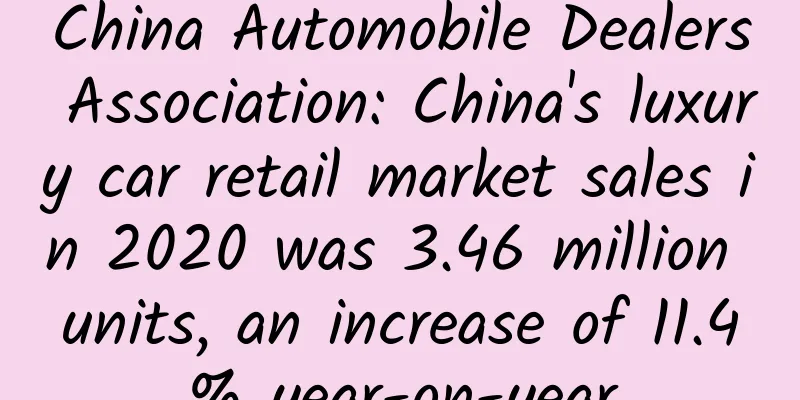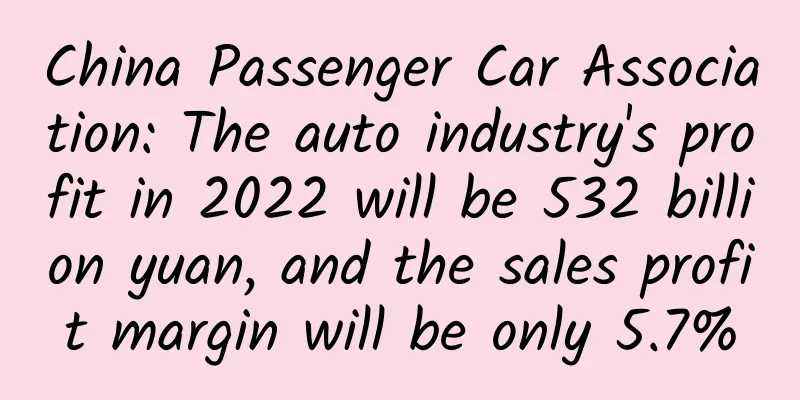China Automobile Dealers Association: China's luxury car retail market sales in 2020 was 3.46 million units, an increase of 11.4% year-on-year

|
In 2020 , calculated from the statistical dimension of insurance data, the sales volume of the domestic luxury car retail market was 3.236 million units, a year-on-year increase of 6.5% , accounting for 16.2% of the overall sales volume of passenger cars . Among them, the sales volume of 14 traditional fuel car luxury brands (accounting for 99.8% of sales volume ) was 3.23 million, a year-on-year increase of 6.5% ; the annual sales volume of super luxury brands was 6,100 units, a year-on-year increase of 15% . If the sales volume of the three electric car brands Tesla, Weilai and Ideal is included, the overall market sales volume of luxury cars will exceed 3.46 million, a year-on-year increase of 11.4% , and the market share will be 17.4% . Among them, the total sales volume of luxury brand new energy models is 285,000 units, a year-on-year increase of 196% , and the sales volume accounts for 8.2% . Among the luxury brand new energy vehicle models, sales of Tesla, NIO and Li Auto exceeded 225,000 units, a year-on-year increase of 233% , with an increase of 157,000 units, accounting for 6.5% of sales ; if the sales of NIO and Li Auto are removed, the sales volume of the luxury car market (including Tesla) is 3.38 million units, a year-on-year increase of 9.8% . • Passenger car and luxury car sales overview (unit: 10,000 units) ▍Increase in luxury car sales drives new car sales profits of luxury car dealers to a new high The increase in sales of new luxury cars in 2020 also led to an increase in dealers' profits from new car sales. Dealers' profits have improved since the third quarter, mainly because manufacturers provided targeted support to dealers during the epidemic and provided dealers with best-selling new car resources. For example, Porsche provided dealers with models such as Cayenne and 911 that are in high demand among consumers ; Audi provided dealers with models such as Audi A6L and Q5L ; manufacturers provided dealers with financial support to reduce dealer inventory; local governments reduced taxes and burdens for enterprises during the epidemic; dealers also continuously optimized operational management and reduced cost support. Judging from dealer profits in the third and fourth quarters of 2020 alone , dealers' profits from new car sales are already better than in previous years; excluding derivative sales, Volvo dealers have made a profit of 1.5-2 points from new car sales by the end of the year, while dealers lost more than 1 point or more in the same period of 2019 ; Porsche and Lexus' best-selling models in November and December 2020 have been sold at a premium, and dealers in East China, South China and other regions can make a new car profit of about 7 points, up more than 2 points from the same period last year; Lincoln has two domestically produced SUV models on the market in 2020 , which brought more new car sales profits to dealers. Lincoln dealers' new car sales profits are nearly 5 points, up more than 2 points from last year. Jaguar Land Rover dealers' profits from new car sales have turned positive. Including derivatives and after-sales, dealers have begun to make profits. 2021 is the full sales year of the best-selling new car Defender, and dealer profits are expected to increase further; Mercedes-Benz and BMW dealers' new car profits will increase by 1-2 percentage points compared with the same period last year; Audi dealers' new car sales have improved significantly from a loss of more than 4 percentage points in 2019 to a loss of about 0.5 percentage points in 2020 ; however, there are also brands whose losses have increased. Cadillac dealers' new car sales have increased from a loss of 1.5 percentage points in 2019 to a loss of 3 percentage points in 2020. Cadillac's sales plan for 2021 is to grow by 15% , but dealers are not willing to do so, and growth is more difficult. ▍New energy vehicles have not yet caused a run on existing luxury car models As the luxury car market grows, the market segment has expanded. In the past, this market segment was occupied by second-tier luxury brands or personalized models, but now it has gradually evolved into electric models. In 2020 , the sales of Tesla, Weilai, and Ideal were equivalent to the annual sales of Lexus. As more luxury brands launch electric models, this market segment will continue to maintain rapid growth. The rapid growth of electric vehicle sales in 2020 did not have much impact on the market price of luxury cars. The new car sales profit of luxury car dealers was also growing, and it was better than in previous years; dealer derivatives and after-sales services are also important profit sectors, which are less affected. In 2020 , electric models in the luxury car price range met the needs of some consumers, especially car buyers in cities with purchase and driving restrictions; with the domestic production of Tesla model Y , the sales of electric models in the mid-size SUV market segment will further increase. The sales of electric models launched by traditional luxury brands in this market segment will be affected due to insufficient product strength. ▍ Luxury cars are expected to maintain a growth rate of about 10% in 2021 , and the growth rate of new energy vehicles is expected to exceed 100% In 2020 , domestic automobile consumption rebounded. According to the data from the National Bureau of Statistics, the total automobile consumption for the whole year was 3.9414 trillion yuan, a year-on-year decrease of 1.8% ; in 2020 , the sales volume of the domestic passenger car retail market was 19.942 million vehicles, a year-on-year decrease of 7.7% ; the retail sales of new energy vehicles reached 1.14 million vehicles, a year-on-year increase of 41% , with an increase of 330,000 vehicles. The effective sales date in 2021 is one month longer than that in 2020. Due to the New Year holiday in February 2020 and the epidemic , the monthly sales of luxury cars were only 34,000 vehicles. Many luxury car companies have included this factor in their sales plans for 2021. In 2021 , the sales volume of traditional fuel luxury brands is expected to maintain a growth of about 10% , and the sales volume of new energy vehicles in the luxury brand price range is expected to achieve a growth of about 100%-200% . • Luxury brand new energy vehicle sales and year-on-year growth (unit: 10,000 vehicles) ▍ In 2020 , Japanese brands saw the smallest sales decline, while domestic brands saw the largest sales decline In 2020 , Japanese brands in the passenger car market sold 4.98 million vehicles, down 1% year-on-year ; German brands sold 5.36 million vehicles, down 7% year-on-year ; American brands, due to the large increase in Tesla's sales, drove the overall retail sales to 1.88 million vehicles, down 2.5% year-on-year . If Tesla is removed, the overall decline of American brands is 8% ; Korean brands sold 720,000 vehicles , down 28% year-on-year ; French brands sold 54,000 vehicles, down 64% year-on-year ; European brands other than French brands sold 280,000 vehicles, down 0.5% year-on-year . In addition, domestic brands sold 6.67 million vehicles throughout the year, down 10% year-on-year , nearly 780,000 fewer than last year . The brands with the largest sales declines include: Baojun with 260,000 fewer vehicles, Geely with 180,000 fewer vehicles, Trumpchi with 110,000 fewer vehicles, Beijing and Roewe with more than 80,000 fewer vehicles, and MG, Wuling, Venucia, and BYD with more than 40,000 fewer vehicles each compared to the same period last year. Domestic brands are mostly concentrated in compact models with low average transaction prices. In 2020 , due to the impact of the epidemic, the economic income of the user groups of domestic brands was greatly affected, and the number of car-buying users also decreased relatively. During the same period, German and Japanese brands launched many new cars in compact models, which also seized part of the market share of domestic brands. • Overview of year-on-year sales decline by brand (unit: 10,000 vehicles) ▍The luxury market was depressed at first and then rebounded, with stable sales of first-tier brands and fierce competition among second-tier brands In 2020 , the automobile market was affected by the epidemic. The monthly sales of the passenger car market in the first half of the year maintained negative growth. The cumulative sales from January to June were 789,000 vehicles, a year-on-year decline of 27% . In the second half of the year, with the improvement of the economy, automobile consumption rebounded . The cumulative sales from July to December were 1.205 million vehicles, a year-on-year increase of 12% . The luxury car market saw a decline in sales only in the first quarter when the epidemic was the most serious. Since April , the overall market has begun to improve. Except for June , it has maintained double-digit growth. Among them , the growth rate from July to November maintained more than 20% . In December , sales reached 369,000 vehicles, a new high for the year; from the perspective of the improvement time node, the luxury car market is one quarter ahead of the overall passenger car market. However , in 2021 , the first quarter will face the consumption overdraft of the fourth quarter of 2020. At the national policy level, there is less policy stimulus for the automobile market. In addition, some regions are affected by the epidemic and other factors. The market may not start very optimistically. This requires car companies to pay attention to this point, control the wholesale rhythm, pay attention to dealer inventory, and stabilize retail market prices. Calculated based on insurance data, the sales of first-tier luxury brands in 2020 were relatively stable, maintaining an increase of more than 5% . Among them, the sales of Mercedes-Benz brand (including V -Class) were 781,000 vehicles, a year-on-year increase of 9.1% , the sales of BMW brand were 759,000 vehicles , a year-on-year increase of 5.9% , and the sales of Audi were 732,000 vehicles, a year-on-year increase of 6.7% . • Overview of year-on-year sales of luxury brands (unit: 10,000 vehicles) Among the second-tier luxury brands, Lexus jumped to the fourth place in luxury car sales with a growth of 17.4% to 235,000 vehicles ; driven by the sales of two new domestically produced cars, Lincoln's annual sales exceeded 62,000 vehicles, achieving a sales growth of 27.8% . Among super luxury brands, Bentley sold 3,200 vehicles throughout the year, up 44% year-on-year , of which the Bentayga accounted for 50% ; Rolls-Royce sold 1,146 vehicles, up 6.6% year -on-year, of which the Cullinan accounted for 59% . The super luxury brands' reliance on large SUV models has further increased. Except for Ferrari, the super luxury brands' deliveries in 2020 have all escaped the impact of the National VI standard. ▍ Sports car sales grew fastest in 2020 , and the SUV segment maintained double-digit growth In 2020 , the fastest-growing market segment was the sports car segment, with 34,000 units sold throughout the year, a year-on-year increase of 24% . Especially after the third quarter, Porsche 911 Boxster , BMW 2 Series Cabriolet, Z4 , 4 Series, Audi A5 and other models were popular in the market. As the luxury car market expands, the demand for consumption upgrades and personalized market segments is also expanding. The market segment with the largest sales volume is still the luxury car segment, with sales of 1.8 million units in 2020 , a year-on-year increase of 7.5% ; the SUV segment grew by 13% to 1.53 million units; another relatively small market segment is MPV . Lexus LM sold 3,200 units throughout the year. Although the sales volume was not large, the sales quality was very good, with an average transaction price of 1.87 million and a sales premium of up to 42% . The same model Alpha (Vellfire) sold up to 23,000 units. • Luxury brand market segment sales and year-on-year overview (unit: 10,000 vehicles) ▍The pure electric luxury car segment will maintain rapid growth If the sales of the three electric vehicle brands NIO, Li Auto and Tesla are included in the luxury brand, the sales of pure electric vehicles exceeded 200,000 units in 2020 , a year-on-year increase of 200% ; plug-in vehicles increased by 72% year-on-year to 46,000 units; fuel vehicles increased by 8% year-on-year to 3.08 million units; pure electric vehicles and plug-in vehicles are the fastest growing market segments. In 2020 , East China was the largest region for luxury car sales, with 1.51 million luxury cars sold throughout the year, a year-on-year increase of 12% ; sales in South China increased by 7.7% to 480,000 vehicles. Shanghai was the city with the highest sales of luxury cars in 2020 , with sales increasing by 19.5% year-on-year to 217,000 vehicles, with Mercedes-Benz, BMW, Tesla, Audi, and Cadillac leading the sales; Beijing was affected by the epidemic for a long time, with annual sales of 169,000 vehicles, a year-on-year increase of 3.6% , and the best-selling brands were Mercedes-Benz, BMW, Audi, Tesla, Volvo, and Lexus. • Sales volume by city level and region and year-on-year growth (unit: 10,000 vehicles) Mercedes- Benz In 2020 , the official sales data of Mercedes-Benz (including V -Class) was 774,000 units, an increase of 11.7% year-on-year . Insurance data statistics show that the sales of Mercedes-Benz (including V -Class) reached 781,000 units, an increase of 9.1% year-on-year . Among them, Mercedes-Benz brand sedans sold 448,000 units, a year-on-year increase of 3% , SUV models sold 306,000 units, a year-on-year increase of 22% ; domestic models sold 626,000 units, a year-on-year increase of 8% , and imported models sold 155,000 units, a year-on-year increase of 12.5% . In the fourth quarter, Mercedes-Benz sold 208,000 units in China , an increase of 18% year-on-year . The average transaction price of the Mercedes-Benz brand in 2020 was 465,000 yuan, an increase of 3,000 yuan compared with the same period last year . Mercedes-Benz dealers' profits from new car sales will increase by more than 1 percentage point compared to 2019. If dealers hold G- Class and Maybach authorizations, and their 4S stores are located in East China, South China and other regions, dealer profits will increase further; Mercedes-Benz brand sales are expected to reach 850,000 vehicles in 2021 . • Mercedes-Benz brand sales and year-on-year overview (unit: 10,000 units) In 2020 , the three domestically produced Mercedes-Benz GLC , E- Class, and C- Class sold a total of 470,000 units, accounting for 60% of Mercedes-Benz's total sales . Among them , GLC sold 165,000 units, a year-on-year increase of 16% ; the sales of the E- Class mid-term replacement were affected to a certain extent, with annual sales of 154,000 units, a year-on-year decrease of 2.5% ; the C -Class will usher in a new generation in 2021 at the end of its product life, with annual sales of 152,000 units, a year-on-year decrease of 6% . In 2020 , Mercedes-Benz's domestically produced compact models Mercedes-Benz A- Class, GLA , and GLB sold a total of 135,000 units, accounting for 17% . Compact models are also a growth point for Mercedes-Benz sales in 2021 . BMW In 2020 , the official sales data of BMW (including MINI ) was 777,000 units, a year-on-year increase of 7.4% . Insurance data statistics show that the sales volume of the BMW brand was 759,000 units, a year-on-year increase of 5.9% . Among them, the sales volume of BMW brand sedans was 419,000 units, a year-on-year increase of 3% , and the sales volume of SUV models was 330,000 units , a year-on-year increase of 9% ; the sales volume of domestic models was 604,000 units, a year-on-year increase of 11 % , and the sales volume of imported models was 154,000 units, a year-on-year decrease of 10% , mainly due to the domestic production of the original imported BMW X2 . The annual sales volume of the MINI brand was 30,000 units, a year-on-year decrease of 12% , mainly due to the replacement of the main sales models. In the fourth quarter, BMW's sales in China were 207,000 units, a year-on-year increase of 3% . The average transaction price of the BMW brand in 2020 was 405,000 yuan, an increase of 12,000 yuan compared with the same period last year . In 2020 , BMW dealers' new car sales profits increased by nearly 2 percentage points compared to 2019 ; in 2021 , BMW brand sales are expected to reach 840,000 units. • BMW brand sales and year-on-year overview (unit: 10,000 units) |
<<: Where is the trigger point for smart homes that are cold on the outside but hot on the inside?
>>: China Automobile Dealers Association: Analysis of China’s automobile exports in 2020
Recommend
WeChat mini-programs can now jump to mobile apps
[[218364]] WeChat announced today that it has ope...
China Automobile Dealers Association: Auto dealer inventory warning index is 52.5% in October 2021
On October 31, 2021, the latest issue of the &quo...
Releasing the scavengers? This is not accumulating merit, it is committing sin
Recently, a piece of news about "releasing s...
Apple opens a backdoor, iOS15 can be downgraded to iOS14.1
Many people complain that iOS becomes less user-f...
The young man did not eat seafood or drink beer, but he got gout! It turns out that soda can also increase uric acid
Daqin, 28 years old, likes to drink beer and eat ...
Meizu Blue has been released, but has Meizu figured it out?
For a good product, why must I rely on low prices...
This is the first time I have seen such a comprehensive information flow optimization case!
After reading this article, you will be able to i...
Traffic volume not increasing? Can’t reduce costs? 3 excellent cases of increasing volume and reducing conversion costs!
What are the most concerns of many advertisers an...
How to quickly customize and develop a WeChat applet? How much does it cost?
How to quickly customize and develop a WeChat app...
How to use data to capture your target users?
A question that operations personnel are usually ...
Practical sharing: What is the hooked addiction model? How to use it to improve user activity and stickiness?
Let me share a new term, the HOOKED addiction mod...
I don't believe the new iPhone design is so ugly, but it may really be a "triple camera"
After Apple suddenly announced a reduction in its...
Antarctica is turning green, but that could be bad news
At present, in the northern hemisphere where my c...
Ranking of 140 information flow platforms, who is the traffic outlet?
As a marketer , we must always pay attention to t...
After being banned for 3 years, WeChat’s important “feature” may return!
Recently, according to feedback from some iOS use...









